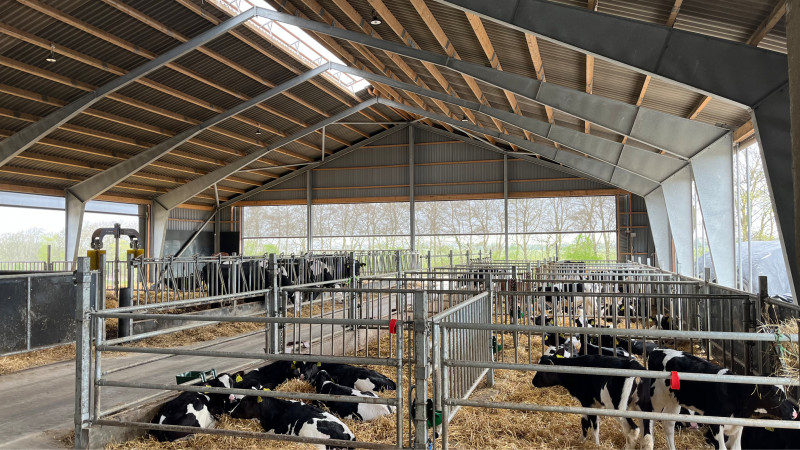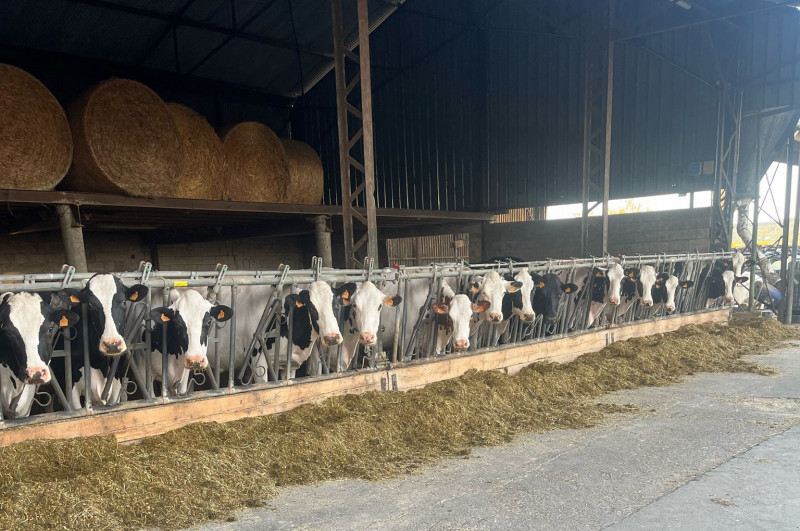
Jacques Bernard

Mamsens in Denmark

One area with the best goal has been achieved is calf mortality. Since the takeover it has been at zero percent.
Bieke de Bruijn already has an exciting life behind her, despite her young age. She was born in the Netherlands, then moved to New Zealand with her parents, and from there to the USA, where she completed her studies in Wisconsin. The covid pandemic began, Bieke moved to Denmark, where she met her husband, Niels Mamsen. ‘When I was in the USA, I was in contact with Meino and that is how it came to be that I was helping at the Holstein International booth at the World Dairy Expo. Now, here in Denmark, Meino’s life partner is our genetic advisor from ABS. The world is so big and yet we still cross paths with same people,’ Bieke says with a laugh. A while ago they decided to switch the herd, which had been exclusively with Viking Genetics, to the GeneAdvance breeding program of ABS, so that the pedigrees are now a mix of North American and Scandinavian sires. Important to them in the selection of sires are primarily the health and production traits. Those are also the focal points in the optimization of operating procedures since the takeover in 2023. Production has increased by more than ten percent since May 2023. ‘To begin, we invested in a new barn for dry cows and calves and increased the cow comfort in the existing barns. Since December 2023 the entire feeding on the farm has been taken over by the Lely Vector. All our friends thought we were crazy to start that sort of project right before Christmas, but for us it wasn’t a problem,’ Bieke reflects. Automatization and data collection are two elements that have top priority for the Mamsens, as it is important to them to continuously improve and to keep diligently doing the things that are working well. One area where the best goal has been achieved is calf mortality. Since the takeover it has been at zero percent (!), which is an exceptional achievement and something the young couple is extremely proud of. ‘A healthy animal is an animal that is easy to manage and requires less time, which is why we have standard procedures for feeding from which we don’t stray. The most important is the colostrum feeding, so that a calf can develop a stable immune system. If we are disciplined in that then we know that the calf will have a good start to its life,’ explains Bieke. For twelve years, Coloquick has been used on the farm for colostrum management and since the middle of last year Bieke has also been working for the company. The feeding plan for the calves that to start there are two feedings of five litres and that the calves are weaned at 70 days. They get free-choice concentrate to the age of 4.5 months and the Vector feeds an additional calf mix. All the data for colostrum feeding, feeding behaviour and treatments are collected and body weights are randomly collected, whereby the average daily gain is about 1100 grams/day within the first month. ‘We want to continue working on the efficiency of our operation, both on the labour side and the feed side, to make life as comfortable as possible for our employees and our animals. Furthermore, we want to collect more data and use it more effectively in terms of implementing it on a daily basis,’ shares Bieke and Niels of their vision for the next few years.
137 cows and 150 heifers 200ha inc. about 50ha wheat, 44ha corn, 30ha grass, 15ha barley, 13ha permanent pasture, 10ha beans, 7ha Hamp and 7ha potatoes Production: 12,500kg/27,500lb 4.5% 3.6% Sire use: Hotwheels, Esparto, Genius, Dagwood, August, Monk, Daluge, Spark P

Thiebaut in France

With an average classification score of 87.4, the Thiebauts were Nr.4 in France last year and this year they have managed to bring the average score to over 88 points.
In northern France, more specifically in Craincourt in the department of Moselle, is the farm of the Thiebaut family, which is operated by parents Olivier and Béatrice along with their son Romain. Romain’s brother Damien, who we spoke with, still helps on the farm when time allows. His primary job is working for a company that produces liquid feed. The farm is a classic mixed French farm with about 50 milking Holsteins and their offspring, crops and beef cows. ‘We have many parcels that are a bit further from our farm and are partly difficult to work, so the Limousin beef cows are a great complement. We market most of the beef directly from the farm,’ explains Damien. His passion, however, is for Holstein breeding, which is why he is often seen at shows, and he helps with the matings on the farm. In this, the Thiebauts put a high value on feet and legs and the mobility of the cows. ‘Our cows have to be able to move well, firstly to get out on pasture and secondly to get around the barn easily. The latter is especially important because with the development of the herd our barn is slightly crowded. Today we are milking 50 cows with almost 11,000kg/24,250lb production in the same building where we used to milk 30 cows with 9,500kg/20,950lb milk,’ Damien continues. The increase in production is one hand due to improvements in feeding and management, and on the other hand through diligent sire selection. In the past they bred only with test sires from French breeding programs, but now the Thiebauts use mostly the top genetics from around the world. Bulls like Spirte, Confirm, Gold Chip and Chief have done a lot of good work for them in the past. Particularly the talents of Chief were discovered by the Thiebauts early on and he worked super well in the herd, as Damien share: ‘We hat 13 doses, of which 10 resulted in pregnancies and of those, 9 were heifers. Currently, 5 of the 9 are still in the herd and they are all in their fourth or fifth lactation and are classified at least VG-88.’ They do their part in contributing to the fact that the herd of the Thiebauts is one of the best classifying herds in France. With an average score of 87.4, they were Nr.4 last year and this year their average increased to over 88 points, so it will be exciting to see the publication of the new list and whether they move further up in this area. And that is exactly the goal Damien has set. He wants to breed cows that have the potential to keep developing and improving from one lactation to the next. To achieve this, the cows must be harmonious and can’t be fully mature in their first lactation. ‘I would rather a small heifer that is still developing in place of another heifer that is already full grown in her first lactation. We let every female calve here and then select vigorously based on the phenotype of the heifers as to which we will keep and which we will sell. In this, we concentrate only on the animal herself and not on the pedigree, as one shouldn’t get too blinded by it,’ describes Damien of their approach that has led their success, and he underlines how proud the family is when happy buyers praise the animals that Thiebauts have sold. Another moment that brought the family pride came to pass just a few weeks ago when the Rompen-Red daughter Tessa was named Reserve Champion for the heifers at the “Vache en piste” show. So, their development going forward will surely be exciting as well.
53 cows and 60 heifers 180ha inc. about 90ha permanent pasture, 10ha grass, 10-15ha corn silage; the rest is cropland for wheat, barley and rapeseed. Production: 10,976kg/24,198lb 4.1% 3.1% Sire use: Sidekick, Lemagic, Luster-P and Rolex